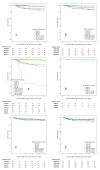Elective Neck Dissection or Sentinel Lymph Node Biopsy in Early Stage Oral Cavity Cancer Patients: The Dutch Experience
- PMID: 32635357
- PMCID: PMC7407164
- DOI: 10.3390/cancers12071783
Elective Neck Dissection or Sentinel Lymph Node Biopsy in Early Stage Oral Cavity Cancer Patients: The Dutch Experience
Abstract
Background: Sentinel lymph node biopsy (SLNB) has been introduced as a diagnostic staging modality for detection of occult metastases in patients with early stage oral cancer. Comparisons regarding accuracy to the routinely used elective neck dissection (END) are lacking in literature.
Methods: A retrospective, multicenter cohort study included 390 patients staged by END and 488 by SLNB.
Results: The overall sensitivity (84% vs. 81%, p = 0.612) and negative predictive value (NPV) (93%, p = 1.000) were comparable between END and SLNB patients. The END cohort contained more pT2 tumours (51%) compared to the SLNB cohort (23%) (p < 0.001). No differences were found for sensitivity and NPV between SLNB and END divided by pT stage. In floor-of-mouth (FOM) tumours, SLNB had a lower sensitivity (63% vs. 92%, p = 0.006) and NPV (90% vs. 97%, p = 0.057) compared to END. Higher disease-specific survival (DSS) rates were found for pT1 SLNB patients compared to pT1 END patients (96% vs. 90%, p = 0.048).
Conclusion: In the absence of randomized clinical trials, this study provides the highest available evidence that, in oral cancer, SLNB is as accurate as END in detecting occult lymph node metastases, except for floor-of-mouth tumours.
Keywords: elective neck dissection; lymph node metastases; lymphatics; oral cancer; sentinel lymph node biopsy.
Conflict of interest statement
The authors declare no conflict of interest.
Figures


References
-
- De Bree R., Takes R.P., Castelijns J.A., Medina J.E., Stoeckli S.J., Mancuso A.A., Hunt J.L., Rodrigo J., Triantafyllou A., Teymoortash A., et al. Advances in diagnostic modalities to detect occult lymph node metastases in head and neck squamous cell carcinoma. Head Neck. 2014;37:1829–1839. doi: 10.1002/hed.23814. - DOI - PubMed
LinkOut - more resources
Full Text Sources
Other Literature Sources

